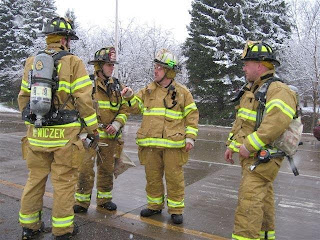This story is
a bit like a snowball that was set in motion by a series of events and the right people coming together at
the right time.
Event #1. Neighboring
fire departments were trying to develop a common RIT (Rapid Intervention Team)
bag that could be used by any department at a fire requiring mutual aid. (For
those unfamiliar with RIT, it is the team of firefighters who are assigned to stand
by to rescue a firefighter in distress or respond to a mayday call at a fire.)
 |
| Eden Prairie Fire Department air pack being scanned into the tracking system. |
Event #2. Those
discussions progressed to thoughts that a common brand of air pack would seem
to make sense, as these departments use “mutual aid’ with each other
frequently. Each department had a different brand of air pack and some were
very loyal to their brand.
Event #3. In
the words of Eden Prairie’s Assistant Fire Chief Steve Koering: “We needed to
get out of the air pack business.” The demands for certification and training of
department technicians—coupled with the ongoing demand for tracking and
accountability—sent a clear message that they needed to focus on their core
competencies. This responsibility, along with the shared risk, could be
transferred to a manufacturer who understood the issues and would create a best
practices solution.
Event #4. “We
saw this as an opportunity to capitalize on the reduced risk while promoting
shared services,” Minnetonka’s Fire Chief Joe Wallin added. Several departments—including Eden Prairie,
Minnetonka, St. Louis Park and Hopkins—worked with the Minnetonka and Eden Prairie City Attorneys
to create a Joint Powers Agreement (JPA) for the purpose of buying a common air
pack and wrapping the air pack maintenance into the agreement with the
manufacturer. The JPA group worked hard in uncharted waters over a 4-year
period to achieve the results realized today. The firefighters quickly overcame
their apprehension of switching brands of air packs and saw the benefits of
collaborative technology. Now bar coding and scanning—tied to a web-based
application that tracks the history of every unit in service from the time the
pack is delivered until it ultimately is replaced or upgraded—is the method for
managing this important information.
 |
| Minnetonka firefighters with turnout gear and air packs purchased through the JPA. |
Event #5. The
group has continued to expand in scope and membership. It now has 20 members,
with six more in the process of joining. One of the new members is in far western
Minnesota. The power of the JPA can now be used for any public safety
equipment. Current agreements exist for SCBA (self-contained breathing apparatus), turnout gear, hose testing, and station
uniforms. Thoughts of adding ladder testing and annual physicals are on the
horizon. Members can access the services they need within the JPA contracts and
can actively participate as members of its Operating Committee.
The SW
Metro JPA is about: responsible government, employee safety, accountability,
and interoperability. It is not about
the money.
So what
about the money then? Ultimately, working together like this saves money in both
the long and the short run as well—and there is no cost to join.
For more
information, contact Steve Koering at (952) 949-8338 or skoering@edenprairie.org
Remember:
Responder Safety = Public Safety
Up next time…"HOT HOT HOT—Summer’s Here!"
In the meantime, stay safe and be careful.
Rob


